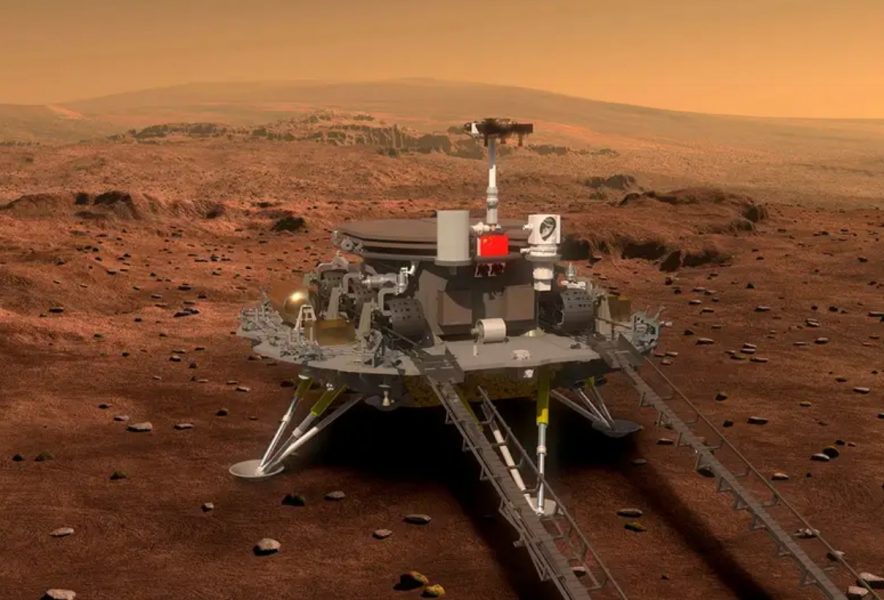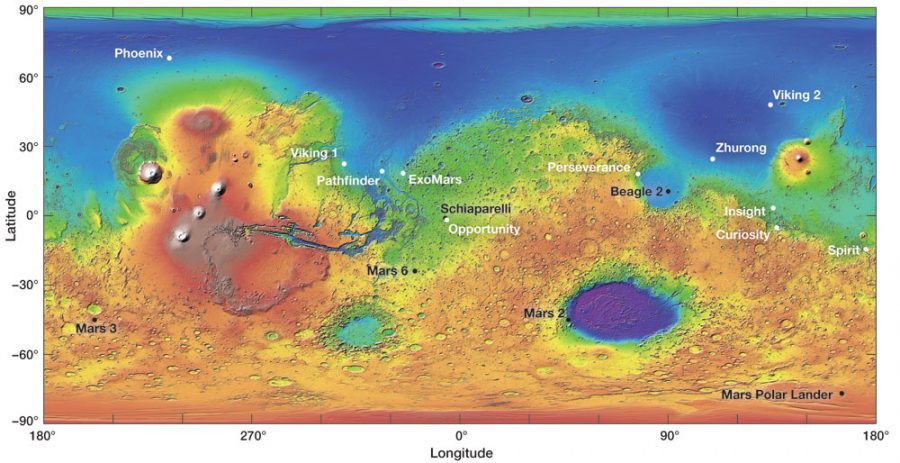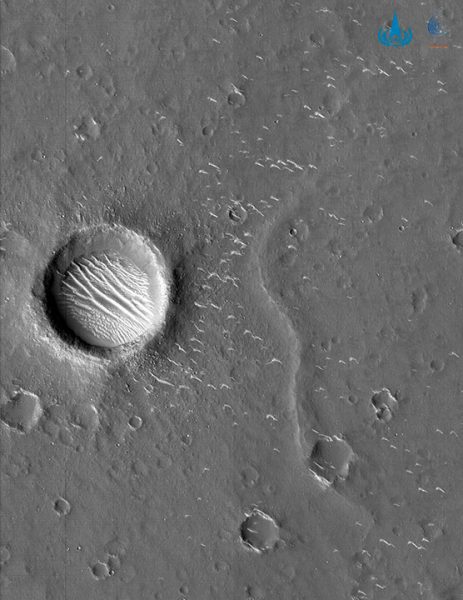The Zhurong rover has successfully landed on the Red Planet in an ambitious first for China’s space agency.
Updates:
Wednesday, May 19th: Images from the Zhurong rover in Utopia Planitia are now trickling out of the CNSA website. We've updated the post below.

CNSA
There’s a new player in the Mars landing club. On May 14th, at 7:18 p.m. EDT / 23:18 Universal Time (UT) (early Saturday Beijing Time), China’s Zhurong rover experienced its own “nine minutes of terror” before touching down on Mars in the plains of Utopia Planitia. The landing site is near 109.9°E, 25.1°N.
This makes China the fifth nation to attempt a landing on Mars and only the second behind the United States to fully succeed. Most recently, European Space Agency’s Schiaparelli lander failed in 2016, and the United Kingdom’s Beagle 2 lander failed in 2003. The former Soviet Union made seven landing attempts and came closest to success with Mars 3 in 1971, which fell silent 110 seconds after reaching the surface.

The Tianwen 1 mission (meaning “questions to the heavens” in Chinese) is an ambitious, all-in-one package including orbiter, lander and rover — a first for any space agency. It launched in July 2020 and arrived in orbit around Mars in February 2021. The orbiter served as a relay for communications during the landing.
Simulation image of the Zhurong rover on its landing platform in Utopia Planitia, from CNSA. https://t.co/8YFFLDmnBP pic.twitter.com/9csHiveTUK
— Andrew Jones (@AJ_FI) May 17, 2021
The rover accomplished entry, descent, and landing using a parachute and retro-rocket combination, followed by autonomous hazard avoidance on final approach.

Welcome to Utopia Planitia

Landing sites: E. Lakdawalla; Basemap: MOLA science team / NASA Goddard
If the name of the landing site sounds familiar, that’s because NASA’s Viking 2 mission successfully landed in the same general region in 1976. China hasn’t released any images from the landing site, and the China National Space Administration (CNSA) only released a brief statement over the weekend to announce that the landing was successful.

“Mars exploration is risky and difficult,” says the translated CNSA press release. “The Tianwen-1 mission has broken through key technologies in interplanetary flight, measurement and control communication, soft landing and achieved (China’s) first planetary landing in a significant development for China’s aerospace industry.”
Now, the 240-kilogram (529-pound) Zhurong rover (whose name means “god of fire” in Chinese) sits atop the landing platform, ready to explore the surrounding plains. The rover/landing platform combination used by Zhurong is similar to the Yutu “Jade Rabbit” combination fielded by China during the Chang’e series of lunar landings. A panorama of the landing site is expected in the coming days.
Congratulations to CNSA’s #Tianwen1 team for the successful landing of China’s first Mars exploration rover, #Zhurong! Together with the global science community, I look forward to the important contributions this mission will make to humanity’s understanding of the Red Planet. pic.twitter.com/KexElIu8OH
— Thomas Zurbuchen (@Dr_ThomasZ) May 15, 2021
Zhurong’s primary mission will last about three months. The solar-powered rover is equipped with six science packages, including a laser spectrometer, a climate weather package, a magnetometer, imagers, and ground-penetrating radar. One of the main goals for Zhurong is to search for subsurface water ice on Mars, providing “ground truth” from its landing site while the Tianwen 1 orbiter searches for the same from its higher vantage point.
Collaboration and Competition
The European Space Agency’s ground-based network and Mars Express orbiter assisted with tracking the Tianwen 1 mission and the landing. Argentina, Austria, and France also collaborated on the mission: Argentina provided ground tracking from its Las Lajas tracking station, Austria developed the magnetometer aboard the Tianwen-1 orbiter, and France supplied a spectrometer calibration target aboard Zhurong that is a duplicate of the one aboard Mars Curiosity.
However, as with much of what China is doing in space, most of the information on the landing came out via state-run television, amateur radio operators monitoring the mission, and observers of the Chinese space program.

CNSA
This successful landing follows a recent string of accomplishments for China’s spaceflight program, including the Chang’e-4 lunar farside mission landing in early 2019, the Chang’e-5 lunar sample return mission in late 2020, and fielding the Tianhe core for its new modular space station just last month.
China has alluded to possible plans to carry out a sample return mission from Mars by the close of the decade. NASA has similar ambitions with Perseverance, which recently landed at Jezero Crater and will stash samples for a future return mission. The next Mars landing in the queue is the European Space Agency’s Rosalind Franklin rover, set to launch in late 2022.
 0
0









Comments
You must be logged in to post a comment.